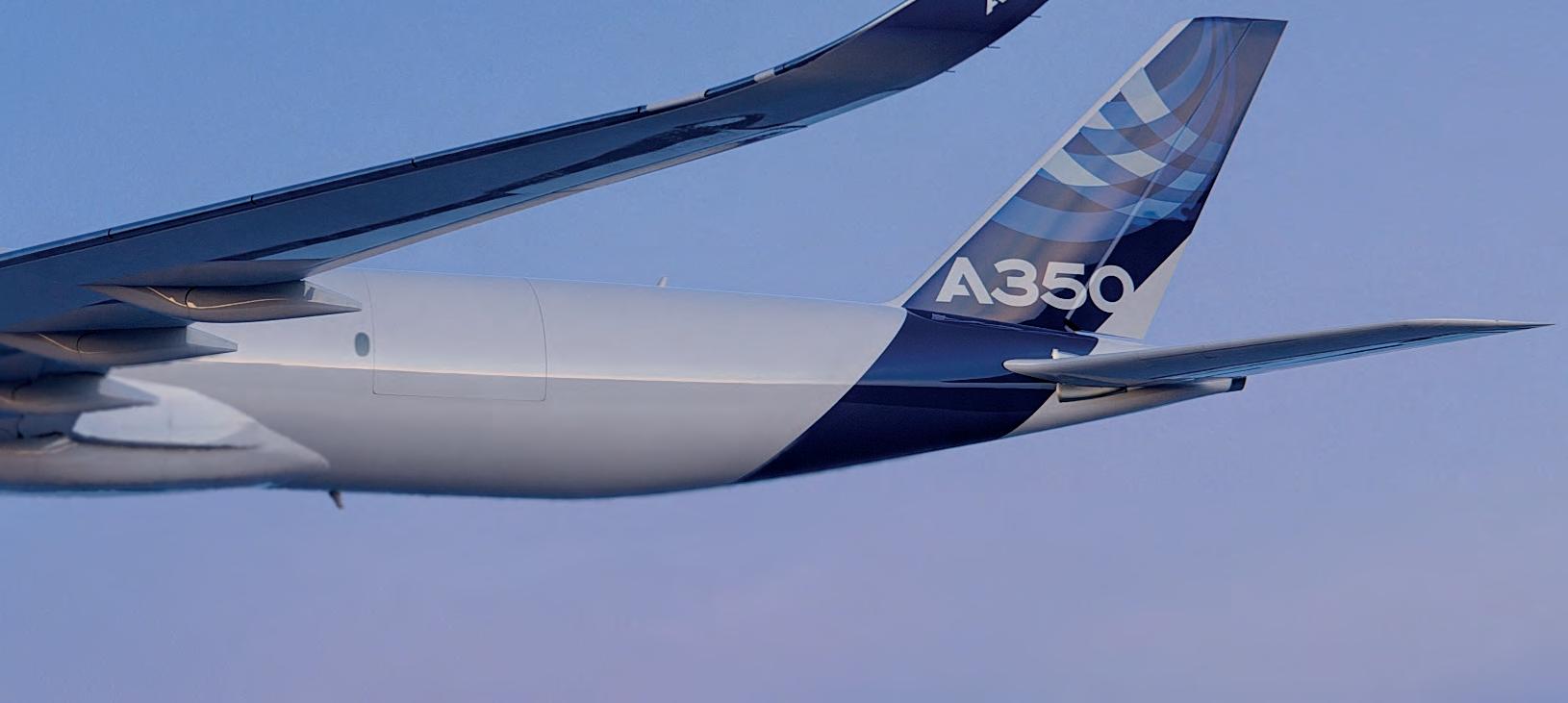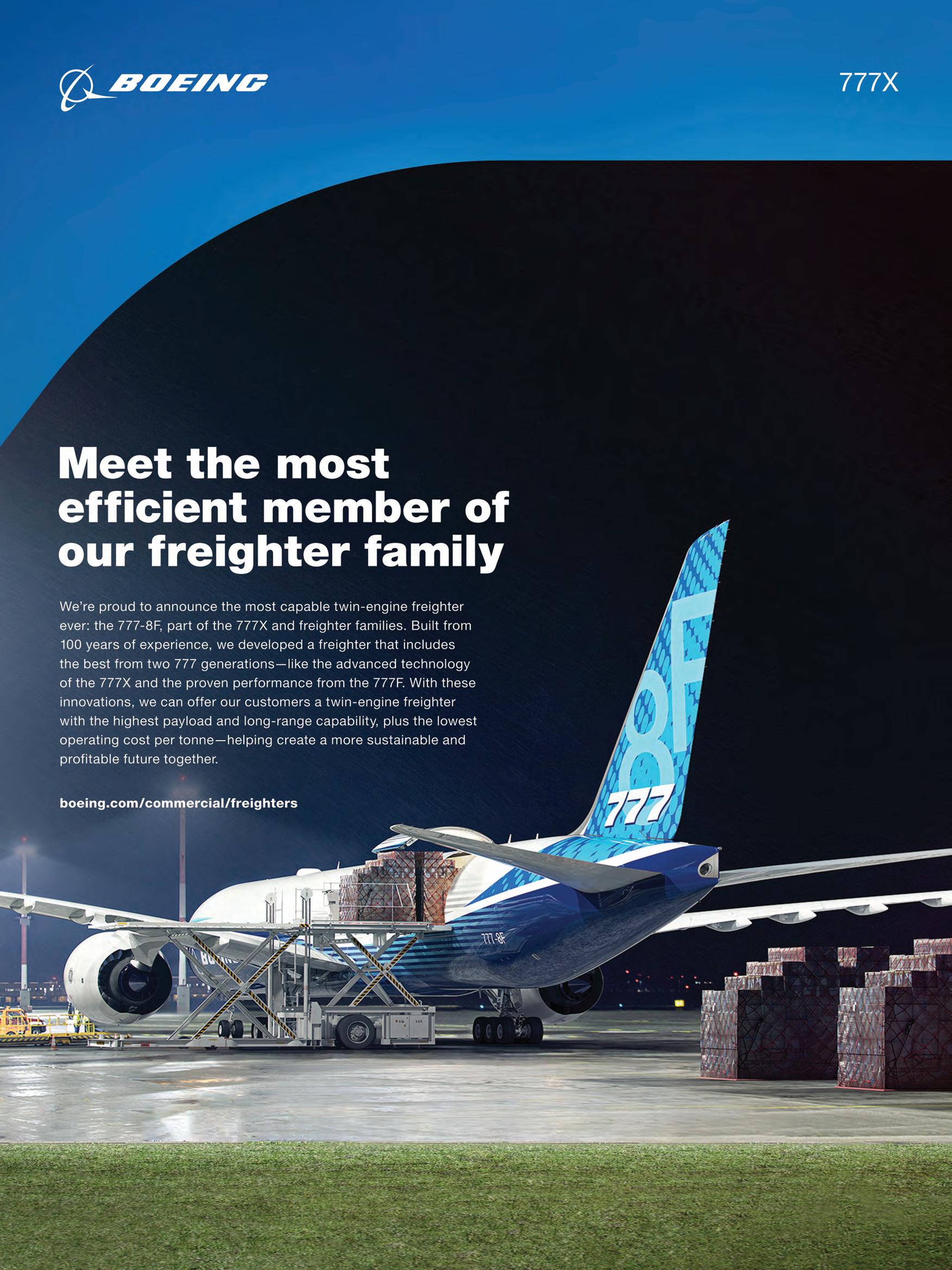

Your guide to the latest developments in the international airfreight industry
MAIN DECK MUSCLE KEEPS
AIR CARGO IN THE AIR

EUROPE’S FREIGHTER FORCE
ATSG: STILL ON TRACK FOR GROWTH




Your guide to the latest developments in the international airfreight industry
AIR CARGO IN THE AIR

ATSG: STILL ON TRACK FOR GROWTH

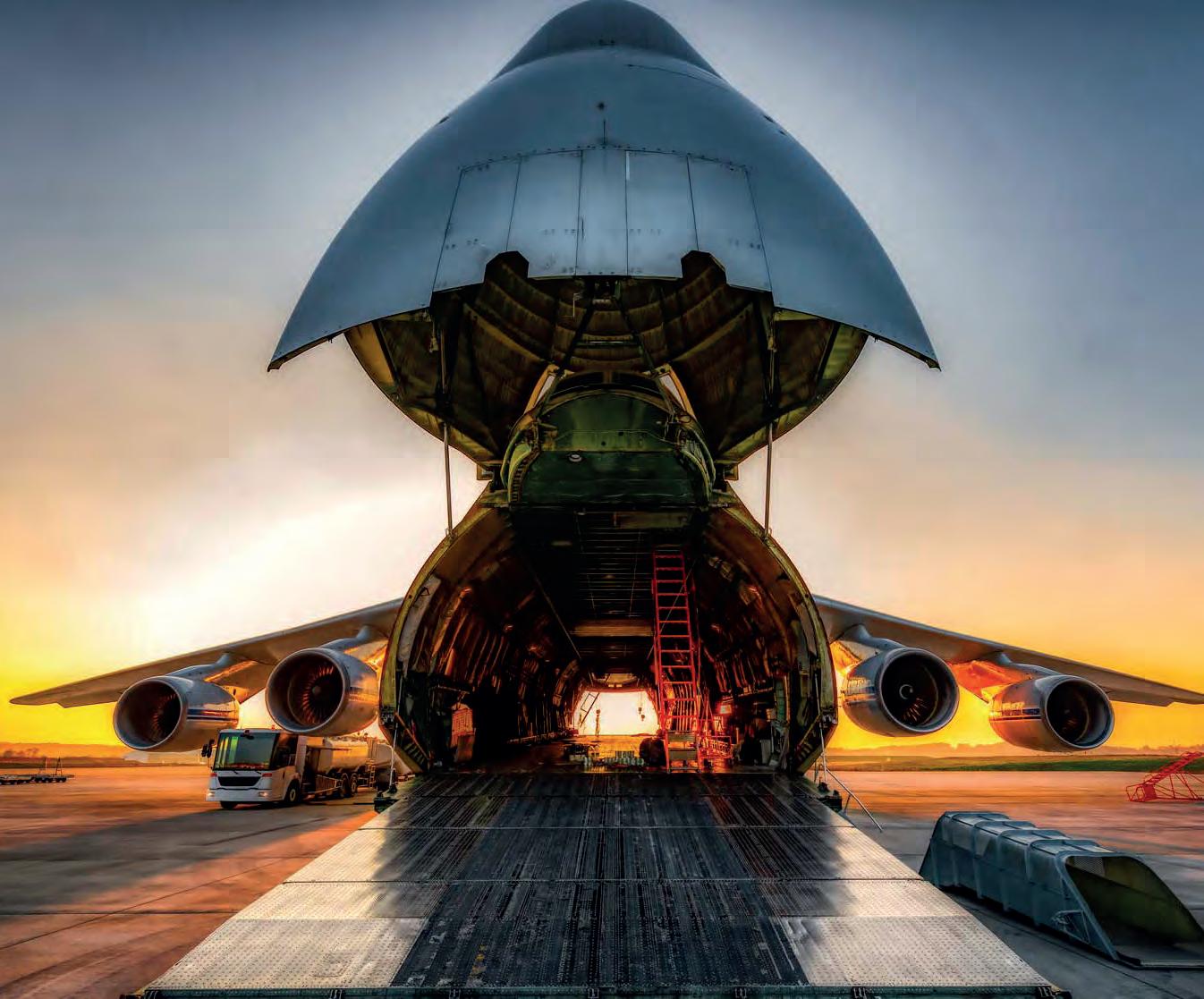
To the typical reader of Air Cargo Week, the freighter aircraft is a straightforward bit of aviation kit that needs little introduction. It can be a purpose-built aircraft that transports cargo on a main deck in a cabin free of the usual passenger amenities. Alternatively, it can be a former passenger aircraft that has been retro-fitted with freight cabin equipment in a conversion that sees the removal of its passenger paraphernalia to enjoy a later lease of life. A disappearing version of the freighter is the Combi-freighter. For most uses, Combi-aircraft have fallen out of favour in modern aviation. Able to carry passengers and freight, with a dual responsibility, they have increased loading times and are forced to keep to passenger schedules while still maintaining cargo operations. This results in a fundamental inefficiency in operations.
However, to the airline customer or freight forwarder, the freighter is often a life-line. They are a life-line when an emergency has devastated a region and rescue material has to be airlifted out in double-quick time; an assembly line faces a stoppage of vital equipment or machinery that must be delivered urgently; a load that must be sent to an airport without regular, scheduled bellyhold capacity; cargo that is simply too large or cumbersome to be placed in the belly; or a live race horse or F1 car that is wanted on the starting grid.
Freighters are in action every day of the year, often behind the scenes of the aviation industry and out of sight of the passenger and general public. Hundreds of freighters, including some of the most modern, are the foundation of e-commerce shipments around the globe. Without freighters, FedEx, UPS, DHL would simply not be able to access overseas markets or deliver their next-day promises.
Airline cargo managers will know that to stuff an aircraft in the
same manner as an ocean container or lorry, is to maximise the advantage of operating without walking cargo.
The first flying of cargo, just eight years after the first heavier-than-air flight, took place in November 1910 in the US, between Dayton and Columbus, Ohio. However it is correctly known simply as a “cargo only” flight solely for the transport of goods as at that time, the later distinction between a freighter and passenger aircraft did not exist.
Although the earliest aircraft were not designed primarily as cargo carrying machines, by the mid-1920s aircraft manufacturers soon spotted the interest in flying cargo and responded by designing and building dedicated cargo aircraft.
A century later, a freighter generally features one or more large doors for loading cargo. Freighters may be operated by civil passenger or cargo airlines, by private individuals or by the armed forces of individual countries. A freighter will likely also have a wide/tall fuselage cross-section, a high-wing to allow the cargo area to sit near the ground, numerous wheels to allow it to land at unprepared locations, and a high-mounted tail to allow cargo to be driven or loaded directly into and off the aircraft.
As many people are happy to purchase a car that has been owned by another, aircraft owners are happy to turn to a former passenger aircraft that has undergone a conversion to a freighter (P2F).
According to aircargopedia, in a piece penned by Jacob Netz, a senior consultant at Air Cargo Management Group, “converting
Editor: James Graham
Associate Editor: Chris Lewis
Director of Operations: Kim Smith
International Sales Director: Rosa Bellanca
International Sales Executive: Zainab Khalid
Finance Manager: Rachel Burns
Video Director: Michael Sales
Design & Production Manager: Alex Brown
Website Consultant: Tim Brocklehurst
Directors: Norman Bamford • Dawn Jolley
military or passenger aircraft to freighters goes back to the very early days of commercial aviation. In 1919, American Railway Express used a converted Handley-Page bomber in an attempt to fly 1,100 pounds of freight from Washington to Chicago. In reality, Air cargo did not pick up significantly until after WWII. With plenty of ex-military aircraft such as DC-3/C- 47, DC-4/C-54s on the market in the postwar period, it was not surprising that some of them were converted to commercial freighters. Later, other piston engine aircraft, such as the Lockheed Constellation and DC-6 (including the Freddie Laker Carvair) were also converted to commercial freighters.”
His observation is that when a dedicated passenger aircraft is almost “reaching its age” after completing its useful operational time in passenger service, it can either be scrapped or recreated again in a different format. Converting such aircraft into freighters is a way to extend the economic life of the aircraft. After all, they once represented considerable investments with a planned working life of decades.
Many cargo airlines choose to operate a first-hand quality converted freighter. These meet the high dispatch reliability required, are more economical for the company and can gain the same amount of revenue without using an expensive new-build production freighter.
“Historically, more than 90% of narrowbody freighters are converted aircraft. Mid-size freighters are divided 50:50 between production and converted freighters. Only one-third of the large widebody freighters are converted passenger aircraft. The trend is to increase the portion of the new production freighters in this segment (converted freighters are considered less fuel efficient),” he writes.
“Most conversions are to freighters, but few small size jets were converted to Combis and fewer to Quick Change (Dual-use aircraft carrying passengers in daytime and freight at night-time).”
Traditionally, production freighters are designated with the letter ‘F’. Converted passenger aircraft are designated with the letters SF. In recent years, three conversion houses use their own designations: BCF
– Boeing Converted Freighter; BDSF - Bedek Special Freighter; PCFPrecision Conversions Freighter.
Many types are converted from passenger to freighter by the installation of a main deck cargo door to access the now empty passenger cabin. Further upgrades and changes to the aircraft body see a change to its control systems and the upgrading of floor beams for cargo loads. Passenger equipment and furnishings are removed and new linings, ceilings, lighting, floors, drains and smoke detectors are added. This type of specialised engineering gives the aircraft up to two further decades of service.
These converted freighters have had most of their development costs already amortised and lead time before production is shorter than for all-new aircraft. At the same time, converted cargo aircraft will invariably use older technology. This can translate into higher direct operating costs than can be achieved with current technology.
A key legacy from their design and use as passenger aircraft can be that, as they have not been designed specifically for air cargo, loading

and unloading is not optimised; the aircraft may be pressurised more than necessary and there may be unnecessary apparatus for passenger safety that remains after conversion.
In a curious throwback to the very start of commercial aviation, in recent years the ‘preighter’ took flight. A preighter, also known as cargo in cabin, was an aircraft originally intended to carry passengers but which was operated temporarily as a cargo aircraft by loading freight in the passenger cabin. The term is a portmanteau of “passenger” and “freighter” and is attributed to Lufthansa chief executive Carsten Spohr; it came to use as commercial airlines responded to the 2020 COVID-19 pandemic.
Prior to the precipitous drop in air travel caused by the outbreak of COVID-19, cargo capacity in the bellyhold of passenger aircraft accounted for half of global airfreight, rising as high as 80% on transatlantic routes. With the cancellation of many passenger flights and the corresponding loss of capacity in holds, existing dedicated freighter aircraft were insufficient to meet demand and air cargo rates increased.
Jets carrying cargo in the passenger cabin could be deployed much faster than existing freighter capacity as the industry fought to make sense of the early months of the global pandemic. With a loss of freight capacity and the urgent need to distribute massive amounts of personal protective equipment (PPE) around the world in the fight against the virus, hundreds of unused passenger aircraft were temporarily employed in a freighter role. Such aircraft also helped deliver mail, medical supplies, tools and other cargo during the difficult times. Loading and unloading a preighter aircraft often required more time and work by airline staff than would a dedicated freighter aircraft. As there was no dedicated system for loading, most of the process had to be completed manually by airline or airport staff. In some cases, it was reported that this took a significant physical toll on ground handling agents.
While none are being operated now as a degree of normality has returned to the industry, it is worth having a look at some of the memorable uses of preighters. In February 2021, British Airways used a B777 aircraft to deliver 1.7 million masks to Germany while Ethiopian operated over 5,600 flights carrying cargo in passenger cabins. Saudia’s first-ever commercial flight to Denmark was operated as a preighter service. With a great effort by airline planners and flying staff, an A380 aircraft was used for temporary cargo operations by both Hi-Fly and Emirates.
However, the preighter crown has to go to Korean Air which flew the longest nonstop flight in the company’s history as a preighter service in June 2021 operating for over 14 hours between Seoul and Miami. The B777 was carrying 15 tonnes of COVID-19 diagnostic supplies headed for the Dominican Republic and made use of both the cargo and passenger areas onboard.
This shows how sometimes a freighter, in whatever form, can be more than just a piece of flying equipment: it can truly be a life-saver.

Air Transport Services Group (ATSG) is a leading provider of aircraft leasing and air cargo transportation services formed of ten group companies. The Wilmington, Ohio-based operation is the largest lessor of freighter aircraft of all types in the world. At the end of 2022, it had ninety-nine 767 freighters under dry lease. This represents almost 2/3 of the overall 767 freighter leasing market.
The group is now branching into A321 and A330 conversions as they will service the same market and current customers; network express operators that provide time-definite and day-definite commitments.
The A321 will be a solid large narrow body replacement for the Boeing 757 freighter, with similar cubic volume, but with a 15-20% fuel burn advantage. The A330 is a logical replacement aircraft for the 767, as feedstock aircraft for the 767 conversion get more difficult to find.
Typically these aircraft are 15-25 years old prior to conversion. ATSG has converted some younger and some older than that range. It really looks at the history of potential aircraft that it purchases for conversion. Many of the aircraft are “cycle-young”, in that they may be 20 years old, but they have only flown 20,000 cycles, and ATSG knows these aircraft can fly up to 50,000.
“We do more than just convert the aircraft; we also upgrade the avionics and upgrade some of the large components where required. When an aircraft comes out of conversion it is set for the long haul.
Because we have airlines that fly 767 freighters, we approach every
conversion as if we were going to be the operator. We are a leasing company that thinks like an airline. The 767 freighter is the backbone for express and integrator operations all over the world, and those networks require high reliability. That’s what we deliver!” says the company.
Rich F Corrado is CEO and president of ATSG and said of Q4 2022: “Operating hours for our airlines continue to grow, and we’re expecting another busy peak season.” Did the peak happen for ATSG?
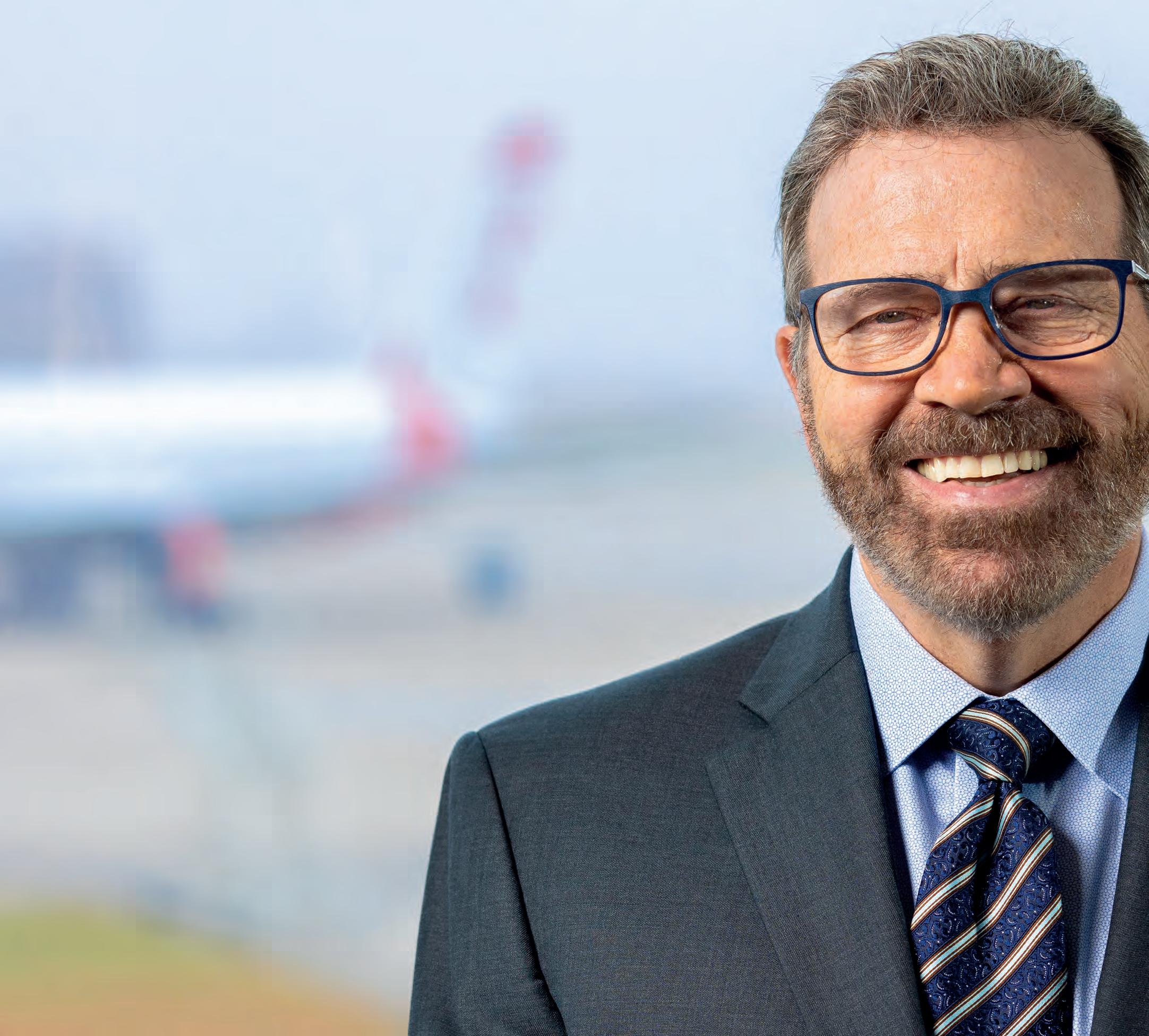
“We did see a peak, but we had grown our operating fleets for DHL and Amazon during the year, so we had an expectation that they would fill that new capacity. The weights of one of our networks were up about 20% during peak (vs. peak 2021) just prior to the weather challenges. We follow e-commerce trends closely as they are a clear demand indicator for our networks, and we saw that Black Friday and Cyber Weekend were both up 3-4% over the prior year,” says the company.
As an owner and lessor of freighters, Corrado knows well that Ohiobased ATSG is “not immune” to the labour and staffing issues that affect many in the US freighter market.
There are pressures in the hiring and retention of staff, especially pilots, in the current economic climate both in the United States and
“We are a leasing company that thinks like an airline”
the foreign markets in which ATSG is involved.

Corrado explains: “The issue is really with licensed positions, pilots and mechanical engineers.” He adds that the training and professional requirement of licensed roles mean there are lags in the supply of newly-trained staff. It can take months to train a pilot, all the time while they are not generating income.
Attracting experienced and trained licensed staff is a better alternative for ATSG. One factor that helps the group attract people is where it sits in the market, he considers. “We are a cool niche as a business,” he says. It is in the middle of the market, as it has a better offering for pilots than regional US airlines while being outgunned by the major airlines.

While employment issues for flight crew may be easing in 2023, the same pressures are felt for mechanical engineers. In relation to this sector, Corrado admits ATSG is “not where we want to be.”
In terms of non-licensed staff, his pressure is a US unemployment rate of around 4% that sees it become a buyer’s market for labour.
At the same time, with ten group companies, how cohesive can the group be with what are hundreds of staff members?
“Our individual subsidiaries operate independently of each other but we also leveraged a bundled solutions strategy to offer our customers a solution that combines leasing, aircraft operations, aircraft MROs and logistics to offer a value proposition that is unmatched
anywhere in the market.
“Our companies work together extremely well but they also need to be stand-alone profitable. The strength in our company comes in the leverage we get across the enterprise. Consider our two largest commercial customers, DHL and Amazon. Both of these customers lease aircraft from our leasing company, Cargo Aircraft Management. They also sub-lease them back to our two operating airlines ABX Air and Air Transport International.
“We fly those freighters under a separate flying agreement. Both customers also use our heavy maintenance MRO, airborne maintenance and engineering services for heavy checks, modifications and line maintenance. Likewise, our logistics company, LGSTX Services has agreements with both customers for additional services including: aircraft handling operations and sort centre operations, material handling equipment maintenance, de-ice services, to name a few. Our leasing company provides both customers engine leases and spare engine support. Clearly, the value of the bundled model makes these customers more ‘sticky’ to ATSG,” notes the company.

Airlines operating freighters generate 90% of industry cargo revenues
• 6 6% of current freighter fleet to be replaced over the next 20 years
• A sia Pacific leads freighter deliveries; fleet size to equal North America by 2041
Boeing’s World Air Cargo Forecast (WACF) is a biennial supplement to the Commercial Market Outlook, focused on a comprehensive and long-term view of the air cargo market Boeing’s World Air Cargo Forecast 2022 (WACF), the biennial addendum to the Commercial Market Outlook, has a dedicated section on its thinking and predictions for the world’s freighter fleet. The contents are detailed and insightful.
“Before the COVID-19 pandemic, freighters made up less than 8% of the total commercial jet fleet, yet they carried more than 50% of all air cargo traffic. As the pandemic continued, at the end of 2021, freighters represented nearly 10% of the total commercial jet fleet and carried approximately 70% of all air cargo traffic,” says the WACF. Dedicated freighter services offer control over timing and routing that lower-hold capacity cannot match. Air cargo is an industrial tool and demand for cargo capacity surges around production schedules as shippers try to use freighters during shipping time between factories as “warehouses in transit.”
Few twin-aisle passenger airline schedules are timed to meet the needs of those industrial shippers. Freighters offer greater speed to market for high-value, time-sensitive products such as capital equipment, electronics, pharmaceuticals, fashion goods and perishable commodities. The lower holds of passenger aircraft are severely limited for transporting hazardous materials and project cargo, a group of shipments moving as one aggregated consignment.
The WACF notes nearly 90% of all air cargo revenue is generated by airlines that operate freighters. By augmenting airline cargo operations, freighters help airlines compete more effectively.
The freighter fleet forecast categorises aircraft by capacity measured in tonnes. Standard body freighters offer less than 45 tonnes of carrying capacity. With the same fuselage cross sections as single-aisle airplanes, standard-body freighters are supplied to the industry almost exclusively through the conversion channel. The uptake of factory-built small freighters has been modest and is not expected to increase.
Medium wide-body freighters have capacities of 40 to 80 tonnes. In cross section, these are twin-aisle airplanes. They are supplied through both conversion and factory production, with the product mix influenced by operator requirements as well as feedstock availability. Large freighters provide more than 80 tonnes of capacity. Although large freighters historically came from both conversion and factory production channels, Boeing believes that future demand will favour factory production. In a segment where utilisation rates often match those of passenger wide-bodies, carriers value the efficiency and unit cost advantages of new, factory-built products.
The WACF freighter fleet forecast points to 3,610 aircraft in service by 2041, an increase of 80% against the in-service 2019 fleet of 2,010. Pre-pandemic, the 2019 world freighter fleet consisted of 2,010 jet aircraft. By the end of 2021, the fleet had grown to 2,250 freighters. At the same time, freighter utilisation operated at approximately 125% of normal levels. The return of parked airplanes to the fleet, combined with higher-than normal operations levels, has added much-needed capacity and will fulfill replacement demands throughout the forecast period. Over the next 20 years, the freighter fleet will grow from pre-pandemic levels by 80%, which represents 3% average annual fleet growth.
Boeing forecasts approximately 2,800 production plus conversion deliveries, with approximately half of them replacing retiring aircraft
“Before the COVID-19 pandemic, freighters made up less than 8% of the total commercial jet fleet, yet they carried more than 50% of all air cargo traffic”
and the remainder expanding the fleet to meet projected traffic growth. Roughly two thirds of all deliveries will be freighter conversions of passenger airplanes, about 70% of which will be standard body aircraft.
Reflecting the higher traffic growth outlook, as well as higher replacement needs, this year’s forecast is up nearly 7% over last year, with increases across all segments. In the standard body segment, the fleet is projected to grow by 90% over 2021 levels, as viable feedstock becomes more available and e-commerce network growth boosts demand. The segment will continue to see conversions to meet growth and replacement demand, with a projected 1,300 conversions. On the replacement side, more efficient airvraft will increase sustainability—and further boost capacity, as today’s conversions are larger than much of the stock being replaced.
In the wide-body segment, the fleet is forecast to grow by nearly 75%. Both conversions and production deliveries are higher than last year. Expanding express networks will drive growth in the medium segment. And, in the large wide-body freighter category, just over half of the 660 aircraft flying at the end of 2021 are nearing retirement age.
As a result, projected new wide-body demand of 515 units will account for both replacements and future growth. New demand for wide-bodies will remain robust, as their advantages in unit cost, utilisation, and range make them vital to operators for long-haul, general air cargo service.
Cargo specialists and general-market operators
Cargo specialists operate only freighters. They may, or may not, contract with passenger airlines for the use of lower-hold capacity. Such players are strong competitors in market niches with specialised requirements such as oversized or cold-chain cargo. General-market operators are often combination carriers, flying both passengers and cargo. They use lower holds on passenger flights to feed freighter flights.
Historically, the passenger lower-hold cargo load factor has been about half the cargo load factor of dedicated freighter operations. The fact that passenger airlines that operate freighters achieve much better lower-hold load factors than those that carry cargo but do not operate freighters, demonstrates the critical role freighters play in creating effective cargo networks. Both operator types tend to use their freighters in similar ways. They fly relatively short stages, loading and offloading cargo at points along a general route in a pattern known as “load building.” Sixth-freedom cargo hubs are another feature of these networks, given that the bilateral agreements covering cargo carriage tend to be more liberal than that involving passenger service. Cargo specialists and general-market operators have high utilisation rates and are successful at building loads that fully utilise an aircraft’s structural and volumetric capabilities. Because these airlines emphasise unit costs over acquisition costs, they prefer large, capable, factory-built freighters.
Express carriers
Express carriers have a distinct business model, considers the WACF. They move large numbers of smaller shipments and use other modes of transport to reach the final recipients. For these carriers, the average cargo density (weight per unit volume) is less than that of general freight operators. The time-definite services they provide offer higher yields.
Utilisation rates (in flight hours per day) can be very low without impacting profitability. Networks tend to be hub-andspoke, with flights arriving at hubs by night and departing quickly to facilitate morning deliveries. Much of this flying is domestic, or within defined trading blocs, rather than on longhaul international routes.
Because payload density and airplane utilisation are lower than those of general freight operators, express operators tend to balance unit cost against acquisition cost and the need to cover network routes with daily or better frequencies. These airlines fly a mix of small to large freighters and source aircraft opportunistically from conversion suppliers or airframe manufacturers. Because of their unique focus on the balance of capability, acquisition cost, and unit cost, express carriers use medium freighters to a greater extent than other cargo airlines. Express carriers also acquire large numbers of standard body freighters through the conversion channel, to support lower-volume nodes in their networks.
Standard Body
<45 tonnes
Boeing 727
Boeing 737
Boeing 757
Boeing MD-80
Boeing DC-9
Airbus A320 Series
Medium Widebody
40–80 tonnes
Boeing 767
Boeing DC-10
Airbus A300/A310
Airbus A330
Ilyushin Il-76TD
Large Widebody
>80 tonnes
Boeing 747
Boeing 777
Boeing MD-11
Airbus A350
Antonov An-124
Ilyushin Il-96T
Source: Boeing WACF 2022
Note: Production and conversion (SF) models assumed for each type unless otherwise specified
Source: OAG/Innovata by Cirium August 2022

Airbus delivered around 66 commercial aircraft to 84 customers in 2022 and registered 1,078 gross new orders. Airbus’ backlog in builds at the end of December 2022 stood at 7,239 aircraft. Included in these totals are a number of production freighter aircraft.
With the all-new A350F still in the development phase in 2022, deliveries were dominated by conversion freighters via Airbus’ partner EFW. Airbus saw 19 deliveries in 2022.
“In 2022 we served 84 customers with 661 deliveries, an increase of 8% compared to 2021. That’s obviously less than we were targeting but given the complexity of the operating environment I want to thank the teams and our partners for the hard work and the ultimate result,” said Guillaume Faury, Airbus chief executive officer. “The significant order intake covering all our aircraft families including freighters, reflects the strength and competitiveness of our product line. We continue our ramp-up trajectory to deliver on our backlog.”
What would Airbus use as a sales pitch for a customer uncertain as to acquire a production freighter instead of a conversion?
“Of course, a production freighter has its advantages as being a clean sheet design optimised from the beginning for the transport of cargo and not needing to take into account the needs of fare paying passengers. This starts with the structure - a simple example is the windows but beyond that we are looking at things like floor structure and higher running loads windows as an example. In addition systems such as the ECS can be highly optimised for the carriage of perishables and animals,” says the company.
Airbus believes the demand for freighter aircraft is linked to the air cargo traffic evolution. Typically, air cargo traffic is driven by international trade, industrial production, and the consumer demand for goods. Based on these drivers, we forecast that air cargo traffic will increase by 3.2% per year over 2019-2041. Freighter aircraft will be required to satisfy this demand.
As the New Year began, more evidence of the importance of freighter manufacture to the European planemaker saw the Air France-KLM Group place a firm order for four A350Fs, the brand new Airbus widebody freighter, to be operated by Martinair Holland, a Dutch cargo airline headquartered and based in Amsterdam Schiphol airport and part of KLM Group. The A350Fs will allow the airline to retire its existing older generation freighters and replace them with a clean sheet cargo aircraft that offers a big step towards more sustainable cargo operations.
“We are delighted to make this major step forward to the A350F. It accelerates Air France KLM Martinair Cargo sustainability ambitions with significant improvement on fuel emissions and complying with most stringent ICAO Chapter 14 for noise and CAEP 8 for NOx. We are fit for the future!” said Adriaan den Heijer, Executive Vice President Air France KLM Cargo and Managing Director Martinair.
The A350F is based on the world’s most modern long range leader, the A350. The aircraft will feature the largest main deck cargo door and a fuselage length optimised for cargo operations. Over 70% of the airframe is made of advanced materials resulting in a minimum 30 tonnes lighter take-off weight, which together with efficient RollsRoyce engines generate an advantage of at least 20% lower fuel burn and CO2 emission over its current closest competitor.
Last summer, Etihad Airways firmed up its order with Airbus for seven new generation A350F freighters, following its earlier commitment announced at the Singapore Airshow. The freighters will upgrade Etihad’s freight capacity by deploying the most efficient cargo aircraft available in the market.
Tony Douglas, Group CEO Etihad Aviation Group, said: “In building one of the world’s youngest and most sustainable fleets, we are delighted to extend our long-term partnership with Airbus to add the A350 Freighter to our fleet. This additional cargo capacity will support the unprecedented growth we are experiencing in the Etihad Cargo division. Airbus has developed a remarkable fuel-efficient aircraft that, in tandem with the A350-1000 in our passenger fleet, supports our commitment to reaching net-zero carbon emissions by 2050.”
Is Airbus looking to develop electric freighters at all? It is following several ways towards decarbonisation. One element is fleet modernisation e.g. by A330P2F or A350F replacing older aircraft such as 767SF and 747F. In addition, more optimised operations support in saving fuel.
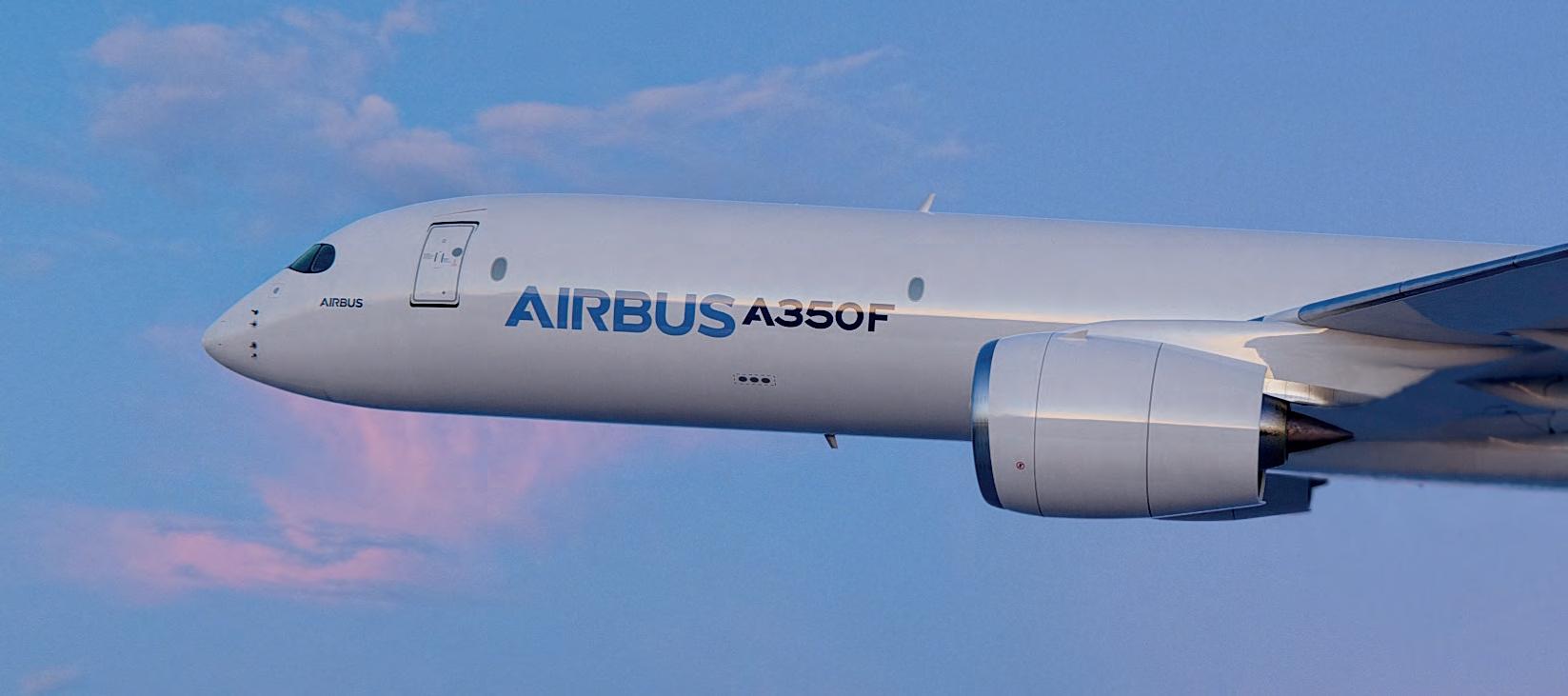
For the future, SAF and Hydrogen both will play a key role when it comes to large freighters. As of today, Airbus aircraft are able to fly with 50% SAF, certification for 100% SAF is ongoing. In addition, Airbus is working with its ZEROe-project on the development of a hydrogen-powered aircraft which should enter service in 2035.
Airbus is exploring autonomous technologies, systems and solutions, as part of a wide analysis on the potential of different technological bricks / tech innovations to further improve aircraft safety while ensuring today’s unprecedented levels are maintained as well as to enhance future operations.
“In 2022 we served 84 customers with 661 deliveries, an increase of 8 % compared to 2021”

